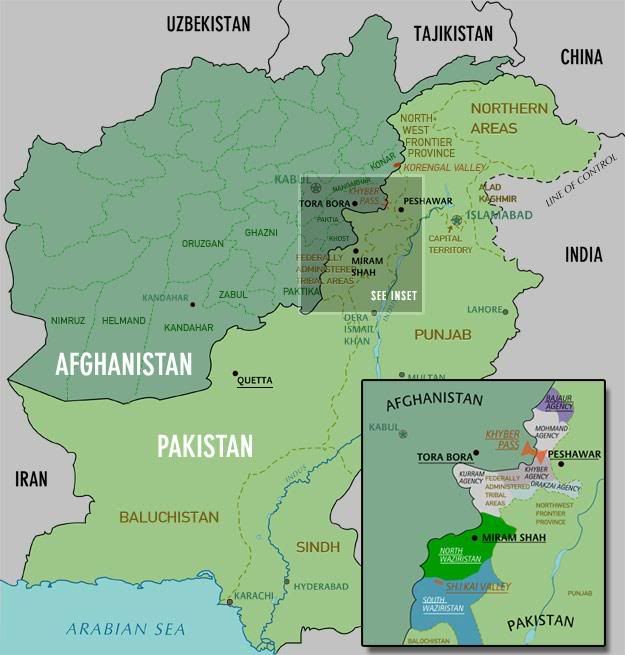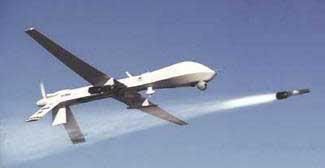
A map from PBS.org 'Frontlines' detailing the Federally Administered Tribal Regions and Waziristan, two central 'homelands' where the Taliban insurgency has taken root.(1)
This means that the cultural and military spheres of influence for the Taliban extend along roughly the same lines as the distribution of their tribal groups. (2) On the Pakistani side of the border, a desperate war is being fought by Pakistani security forces to contain the growing spread of radicalism and fundamental Islamic conservatism within their own borders. In recent months, conflicts have rocked the particularly volatile Swat valley and Pakistan has raided militant compounds located well within its own geographical borders.
Over the last year, some 70 attacks have also been staged inside Pakistani territory, ostensibly by American forces. There have been no troop incursions across the border, nor has traditonal American air power been engaged in bringing the fight to a distant and inaccessible foe. A relatively new military technology, that of combat drones, more specifically the 'Predator' and 'Reaper' drones, has allowed the United States and its allies to bring the fight wherever it is needed, with a high degree of accuracy and relatively low margin of error. (3) Contrary to what the name implies, while Predator and Reaper drones are in fact unmanned, they are not autonomous. A human operator controls the drone remotely and the device is first used to conduct aerial surveillance before the order to deploy an Air-to-Ground PGM (Precision Guided Missile) is given. While the potential of this technology is lifesaving, in that it removes much of the risk factor for the combat personnel, the perceived incursion against Pakistani sovereignty has not gone unchallenged.(4)
In this undated photo, a Predator drone is seen to be firing a 'Hellfire' PGM, the same type of munitions being employed against the Pakistani Taliban.
A recent survey conducted by the International Republican Institute, (5) a not-for-profit group based in the United States indicated that 80% of Pakistanis stand against their government's support for the NATO ISAF war, a remarkable increase of 19% from only a few months ago. Whether this can be directly attributed to drone strikes is not demonstrable, but the same respondents also polled low (77% in opposition) on the issue of America and her Allies broadening the front into Pakistan's Border Regions.
The challenge for NATO personnel is that the Taliban, chief adversaries to the stabilization and reconstruction of the Nation of Afghanistan, have now moved their physical center of gravity to well within the Pakistani tribal regions. (6) The majority of their support networks, inflow of arms, equipment and internal leadership have been outsourced to Pakistan, where beyond drone strikes and increasingly unpopular internal operations by the Pakistani Military, they face relatively few risks. That the Taliban have been free to withdraw further into the Pashtun Belt and continue plotting attacks from within the relative safety of another country's geographical border confounds many of the best attempts by international forces to restore order and governance to the troubled nation of Afghanistan.
In a few days time, a potentially major new front will be opened as the Pakistani military commences operations (announced Oct 1st, 2009)(7) they have been planning for several months. A large number of troops will be entering the tribal region with the intent of combating the insurgency there. The plan was drafted in the wake of the death of the top Taliban commander Baitullah Mehsud (8) in an August drone strike. His death it was hoped, would fragment the command structure of his personal army, comprising of approximately one understrength division of irregular guerrillas, which once formed the core guard of the Pakistani Taliban.
“We thought that Baitullah’s death would unravel the Mehsud militant group and galvanize the tribe to stand up to the people they have suffered from... It didn’t happen.”
What is certain, is that the fighting, due to commence any day now, and timed during the region's fall and winter months where most militants ususally return to their mountain hideouts and rural dwellings, will not be easy for the Pakistani Military. With rapidly diminishing support inside of Pakistan for these operations, dislodging the Taliban from their new physical center will be no easy task. The last two operations within Waziristan by the Pakistani Military actually led to the capitulation of the Military who were forced to withdraw after suffering heavy losses.
For the average citizen of Pakistan, it is business as usual. The same poll, conducted by the IRI revealed that 13 per cent of respondents felt that terrorism was the primary institution causing internal instability in the nation. Instead, privation and economic necessity were their major concerns with 72 per cent saying the suffering Pakistani economy had affected their lives in the past year. Within Pakistan, the need to uproot the insurgency may not be acknowledged, but within the international community, it is recognized that if there is a hope of providing security to the troubled nation of Afghanistan, the greatest change from this point forwards will likely have to occur within these tribal regions.
For the average citizen of Pakistan, it is business as usual. The same poll, conducted by the IRI revealed that 13 per cent of respondents felt that terrorism was the primary institution causing internal instability in the nation. Instead, privation and economic necessity were their major concerns with 72 per cent saying the suffering Pakistani economy had affected their lives in the past year. Within Pakistan, the need to uproot the insurgency may not be acknowledged, but within the international community, it is recognized that if there is a hope of providing security to the troubled nation of Afghanistan, the greatest change from this point forwards will likely have to occur within these tribal regions.
NPR Radio Broadcast from October of last year, talking about the border situation between Afghanistan and Pakistan. (9)
Sources:
1. PBS.ORG: Frontline 'Return of the Taliban'
2. Wikipedia - Federally Administered Tribal Areas (FATA)
3. Wikipedia - MQ1 Predator Drone
4. The Globe and Mail - '80% of Pakistanis against helping US fight militants'
5. The International Republican Institute Homepage
6. West Point - CTC Sentinel - Profile of Tehrik-i-Taliban in Pakistan(PDF)
7. New York Times - 'Pakistan to Target Taliban Epicenter'
8. BBC - Obituary: Baitullah Mehsud
9. NPR - All Things Considered (Podcast)
.jpg)

No comments:
Post a Comment